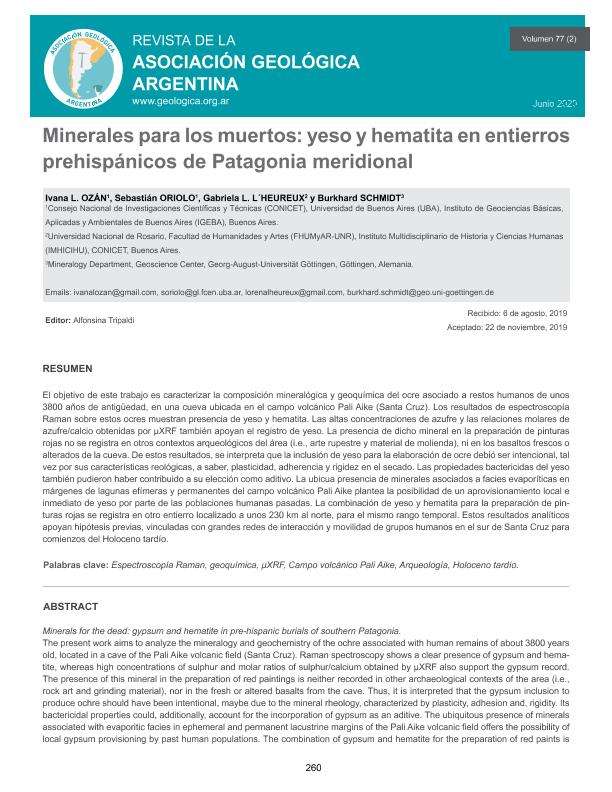Artículo
El objetivo de este trabajo es caracterizar la composición mineralógica y geoquímica del ocre asociado a restos humanos de unos 3800 años de antigüedad, en una cueva ubicada en el campo volcánico Pali Aike (Santa Cruz). Los resultados de espectroscopía Raman sobre estos ocres muestran presencia de yeso y hematita. Las altas concentraciones de azufre y las relaciones molares de azufre/calcio obtenidas por µXRF también apoyan el registro de yeso. La presencia de dicho mineral en la preparación de pinturas rojas no se registra en otros contextos arqueológicos del área (i.e., arte rupestre y material de molienda), ni en los basaltos frescos o alterados de la cueva. De estos resultados, se interpreta que la inclusión de yeso para la elaboración de ocre debió ser intencional, tal vez por sus características reológicas, a saber, plasticidad, adherencia y rigidez en el secado. Las propiedades bactericidas del yeso también pudieron haber contribuido a su elección como aditivo. La ubicua presencia de minerales asociados a facies evaporíticas enmárgenes de lagunas efímeras y permanentes del campo volcánico Pali Aike plantea la posibilidad de un aprovisionamiento local e inmediato de yeso por parte de las poblaciones humanas pasadas. La combinación de yeso y hematita para la preparación de pinturas rojas se registra en otro entierro localizado a unos 230 km al norte, para el mismo rango temporal. Estos resultados analíticos apoyan hipótesis previas, vinculadas con grandes redes de interacción y movilidad de grupos humanos en el sur de Santa Cruz para comienzos del Holoceno tardío. The present work aims to analyze the mineralogy and geochemistry of the ochre associated with human remains of about 3800 years old, located in a cave of the Pali Aike volcanic field (Santa Cruz). Raman spectroscopy shows a clear presence of gypsum and hematite, whereas high concentrations of sulphur and molar ratios of sulphur/calcium obtained by µXRF also support the gypsum record. The presence of this mineral in the preparation of red paintings is neither recorded in other archaeological contexts of the area (i.e., rock art and grinding material), nor in the fresh or altered basalts from the cave. Thus, it is interpreted that the gypsum inclusion to produce ochre should have been intentional, maybe due to the mineral rheology, characterized by plasticity, adhesion and, rigidity. Its bactericidal properties could, additionally, account for the incorporation of gypsum as an aditive. The ubiquitous presence of minerals associated with evaporitic facies in ephemeral and permanent lacustrine margins of the Pali Aike volcanic field offers the possibility of local gypsum provisioning by past human populations. The combination of gypsum and hematite for the preparation of red paints is recorded in a contemporaneous human burial located about 230 km to the north. Therefore, present analytical results support previous hypotheses, related with large human networks across southern Santa Cruz, for the beginning of the late Holocene.
Minerales para los muertos: yeso y hematita en entierros prehispánicos de Patagonia meridional
Título:
Minerals for the dead: gypsum and hematite in pre-hispanic burials of southern Patagonia
Fecha de publicación:
30/06/2020
Editorial:
Asociación Geológica Argentina
Revista:
Revista de la Asociación Geológica Argentina
ISSN:
0004-4822
e-ISSN:
1851-8249
Idioma:
Español
Tipo de recurso:
Artículo publicado
Clasificación temática:
Resumen
Archivos asociados
Licencia
Identificadores
Colecciones
Articulos(IGEBA)
Articulos de INSTITUTO DE GEOCIENCIAS BASICAS, APLICADAS Y AMBIENTALES DE BS. AS
Articulos de INSTITUTO DE GEOCIENCIAS BASICAS, APLICADAS Y AMBIENTALES DE BS. AS
Articulos(IMHICIHU)
Articulos de INST.MULTIDISCIP.DE HISTORIA Y CS.HUMANAS
Articulos de INST.MULTIDISCIP.DE HISTORIA Y CS.HUMANAS
Citación
Ozán, Ivana Laura; Oriolo, Sebastián; L'heureux, Gabriela Lorena; Schmidt, Burkhard; Minerales para los muertos: yeso y hematita en entierros prehispánicos de Patagonia meridional; Asociación Geológica Argentina; Revista de la Asociación Geológica Argentina; 77; 2; 30-6-2020; 260-270
Compartir




